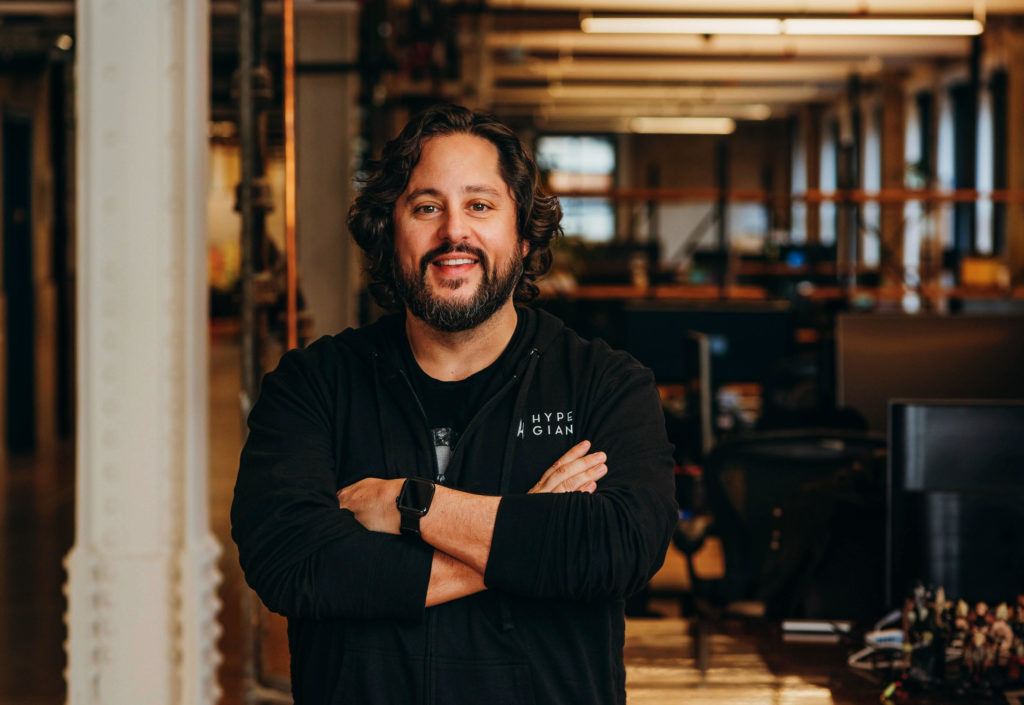
By LAURA LOREK, publisher of Silicon Hills News
At Hypergiant’s Austin headquarters, Ben Lamm, CEO, and Co-founder takes to the conference room’s whiteboard to explain its structure and expansion plans.
Hypergiant launched out of stealth mode in February of 2018 and has been growing steadily with 140 employees in Austin, Dallas, Houston, and Seattle. Its Austin office is on the fourth floor of the iconic 110-year-old Scarbrough building, Austin’s original office tower at Congress and Sixth Street in the heart of downtown.
Lamm, a native of Austin, splits his time between homes in Austin and Dallas and often rides the Vonlane luxury bus between the two cities. He’s already built and sold Chaotic Moon to Accenture and Conversable, which sold to New York-based LivePerson. Hypergiant is his third tech startup in less than a decade. But Hypergiant is his most ambitious undertaking to date.
“It’s been a good first year,” Lamm said.
Hypergiant’s Austin office is space-age cool with murals of “Tomorrowing Today: the space where impossibility intersects reality.” It’s like something out of Disneyland’s Tomorrowland theme park – a poster of which hangs in its conference room. The office features exposed brick, original doors and fixtures, hardwood floors, high ceilings and an open floor plan. Hypergiant’s vibe is a Venn diagram of “high fashion, meets government lab, meets retro futurism,” Lamm explained.
And Hypergiant is serious about conquering the next great frontier, which is outer space. Its swag is even Hypergiant branded freeze-dried astronaut ice cream, the kind they have at the International Space Station and in the gift shop at the Kennedy Space Center. It harkens back to the nostalgia around the great space race.
This summer, July 20, marks the 50th anniversary of the first humans landing on the moon as part of NASA’s Apollo 11 lunar mission, and it seems like the right time for Hypergiant to be focused on outer space.
Lamm explains the somewhat complex structure of Hypergiant on the company’s whiteboard. He draws an org chart showing Hypergiant Industries as the overall parent company. It is the “AI Industrial complex” for Fortune 500 companies and government agencies and federal contractors, Lamm said. It builds and buys companies focused on AI and machine learning to work on problems for customers.
Since Hypergiant emerged from stealth mode last year, it has launched Hypergiant Space Age Solutions, Hypergiant Galactic Systems and Hypergiant Sensory Sciences. Its investment division, Hypergiant Ventures, has also acquired two companies, Black Pixel in Seattle and S.E.O.Ps in Houston.
“We are building the brand for artificial intelligence and changing the world in a lot of different industries. I don’t think all the best ideas will be invented here by me or the founders” Lamm said. “I think the right scenario is let’s go find great girls and guys to build full product companies around areas of expertise that they are passionate about that we can then take to market and wrap additional services around.”
Each one of these companies is individually capitalized, and partially capitalized by our parent Hypergiant, Lamm said. Hypergiant has not disclosed how much in venture capital it has raised to date, but it’s a significant sum, he said.
Hypergiant Space Age Solutions is the service company focused on system integration, custom software development and strategy services for the Fortune 500 on the commercial side and then also working with some great folks on the federal side as well, Lamm said.
“You can go build the greatest enterprise artificial intelligence system to solve XYZ problem, but you still need humans to go train it and integrate it with back end systems,” Lamm said.
Hypergiant builds or buys custom AI software companies that it takes to market through Hypergiant Space Age Solutions, Lamm said.
Last November, Hypergiant Sensory Sciences launched and is focused on spatial intelligence or creating a software platform that uses artificial intelligence, machine learning and neural networks to harvest information from data streams collected by companies through cameras and sensors. It will turn that information into actionable insights a company can use to operate better and more efficiently.
Hypergiant Sensory Science’s initial focus will be on the oil and gas industry, the Department of Defense and healthcare.
“A lot of Fortune 500 companies are excited about AI, but they really don’t understand AI,” Lamm said. “They are more excited about the hope of AI more so than anything.”

This leads into Hypergiant’s Space division, Lamm said.
The latest division to launch is Hypergiant Galactic Systems, which focuses on AI-driven software and hardware products for the space industry. As part of that strategy, Hypergiant acquired Satellite & Extraterrestrial Operations & Procedures, also known as S.E.O.P.s, a Houston-based satellite deployment and services provider for the CubeSat and MicroSat markets. It plans to launch a series of miniature satellites next year.
The first satellite will use Hypergiant’s new Smart Satellite Platform, which is an AI-driven satellite operating system. It will contain special sensors and cameras that allow it to scan the space environment and make sense of the data it collects.
“We can launch our own satellite imaging systems,” Lamm said. “We can sell data from our satellites and leverage our deep learning platform on that data.”
Each one of these divisions have a lot of different market sectors but the goal is to add up all these divisions and leverage them to create something even larger, Lamm said.
Hypergiant has two more companies to announce later this summer, Lamm said. And it will continue to look for new opportunities, he said.
“It’s a big vision, it’s an exciting vision” Lamm said. “This is not a $100 million venture; this is a $100 billion venture. “
And he plans on building a 1,000-year-old company, he said.

Hypergiant has projects that are further out there and other ideas that have shorter return event horizons, said John McKinley, a strategic adviser and investor in Hypergiant.
“It’s trying to get people to stretch their own collective visions of what’s possible,” McKinley said.
“I think there is an incredible demand for people who can deliver innovation in the AI sector reliably. That’s why you’ve seen them grow so quickly over their first year,” McKinley said. “Clients appreciate the fact they are able to deliver on their innovation commitments.”
“Hypergiant is already doing a great job in helping clients reinvent their customer-facing experiences dramatically change their cost structures and deliver a next generation set of products and services to their customers,” McKinley said.
For example, Hypergiant created an AI-powered bartender for TGIF restaurants.
“The AI powered bartender has the ability to understand a specific guest’s likes, dislikes, mood and create a one of a kind drink for that guest for just that meal and just that night,” said Sherif Mityas, Chief Experience Officer of TGIF.
TGIF is piloting the technology in several restaurant and it is starting to roll it out across the chain, Mityas said.
The interactive experience involves a person answering questions on an iPad at the bar around their preferences and whether they like pomegranate, cinnamon and what kind of allergies they have and what they want to eat that night. The AI then creates a recipe for a one of a kind drink.
“Our bartenders love it,” Mityas said. “They get to make cool new drinks.”
TGIF is looking at other AI tools to help it create that one to one connection with guests, he said.
“AI will never replace our people at Fridays, but it is making them much better and enhancing the experience they provide to our guests,” Mityas said. “We’re working with a number of things with Hypergiant. They think differently and help our teams focus on what’s next.”
